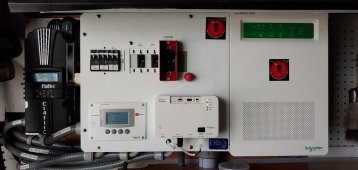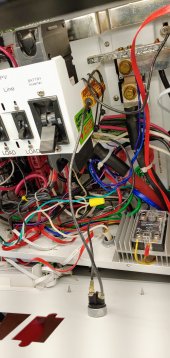MurphyGuy
It just needs a bigger hammer
- Joined
- May 20, 2020
- Messages
- 4,129
Up until Last week I had never heard of pre-charging a larger inverter before connecting the battery cables. I just lived with the spark. But I was watching a "Will" video about a DIY LFP build and saw that he used a resistor before connecting the Positive Terminal. This peaked my interest, and after poking around on the forum and asking a few questions, I decided it was time to put one on my system. I guess all manor of possible nasty things can happen and the little spark can be damaging to connections, DC breakers, and / or capacitors hidden deep within the inverter.
So I rounded up all the necessary parts and a few tools (like a cone shaped step drill bit) and it all arrived today. It was a fun project and works perfectly. The push button is very robust and about the size of a quarter. It is rated for 12v 60am or 24v 30amp according the seller on Amazon. I put in a Gold anodized aluminum 100w 50 OHM resistor and used 12awg stranded wire. Yeah most of that was overkill, but I wanted it to be robust. Very happy with the out come.
Please Let me know if I did anything wrong or what could have been done better. As always, its a work in progress.
Here is the Push Start Button and Resistor.
The squares on the mat are 1 inch.
View attachment 42814
Here are the Links
Fastronix Heavy Duty Push Button Momentary Start Switch
LM YN 100 Watt 50 Ohm 5% Wirewound Resistor
Here is the Step Bit that makes the holes. I had never seen one of these before. I LOVE this tool
Titanium Step Drill Bit
Here is the Schneider Conext SW 4024 Before Install
Here it is in its native habitat surrounded by the Midnite Soar E-Panel and the Classic 150 SCC
View attachment 42815
The Hole for the Push Button Came out Nice
View attachment 42816
Wiring it all up was pretty straight forward
I came off the back of the 250 amp breaker on the battery side
Thru the Push button and on to the resistor
Connected it at the main Positive (+) Inverter Input
View attachment 42817
View attachment 42819
And here is how it all came Together.
I plan to place a label and instructions when I go to my office and get my label maker tomorrow.
View attachment 42820
Hope this helps anybody. Like I said, I had never heard of a Pre-Charger or Pre-Charging, but it sure makes sense, especially with hi-dollar gear. Thanks to this Forum and to all of you who answered my questions when I "hijacked" other threads.
MIke
If I might make a suggestion.. When you activate it, monitor the temperature of your resistor.. its probably not an issue but those resistors are designed to be mounted to a heat sink with compound. I'm guessing the short duration pulse you're pushing through it won't have time to do anything but make it luke warm, but you should check it to be sure. You might have to attach a 1/4 thick aluminum plate under it as a heat sink.
I use a 10W power resistor in the same aluminum case and it heats up pretty quickly.





